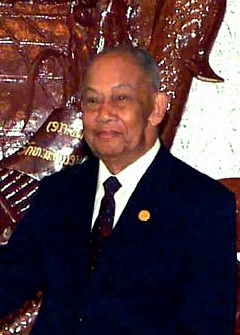
The politics of the Lao People's Democratic Republic takes place in the framework of a one-party parliamentary socialist republic. The only legal political party is the Lao People's Revolutionary Party (LPRP). The head of state is President Thongloun Sisoulith, who is also the LPRP general secretary, making him the supreme leader of Laos. The head of government is Prime Minister Sonexay Siphandone.

Kaysone Phomvihane was the first leader of the Communist Lao People's Revolutionary Party from 1955 until his death in 1992. After the Communists seized power in the wake of the Laotian Civil War, he was the de facto leader of Laos from 1975 until his death. He served as the first Prime Minister of the Lao People's Democratic Republic from 1975 to 1991 and then as the second President from 1991 to 1992.

The Lao People's Revolutionary Party (LPRP) is the founding and sole ruling party of the Lao People's Democratic Republic. The party's monopoly on state power is guaranteed by Article 3 of the Constitution of Laos, and it maintains a unitary state with centralised control over the economy and military.

General Khamtai Siphandone is a Laotian politician who was Chairman of the Lao People's Revolutionary Party from 24 November 1992 to 21 March 2006 and President of Laos from 24 February 1998 to 8 June 2006, when he was replaced by Choummaly Sayasone. He was a member of the Communist Party of Indochina in 1954 and a member of the Central Committee of the Lao People's Revolutionary Party in 1956.

Laos elects a legislature nationally and the public also participates in the election of village heads. The National Assembly has 164 members, elected for five year terms.

The Prime Minister of the Lao People's Democratic Republic, formerly the chairman of the Council of Government of the Lao People's Democratic Republic, is the head of government of Laos. The highest position in the government, they direct the country's executive branch. The prime minister is accountable to the president, the National Assembly and the country's only legal party: the Lao People's Revolutionary Party (LPRP). The current prime minister is Sonexay Siphandone, who was elected in 2022.

This article details the history of Laos from 1945 to the present.

Lieutenant General Choummaly Sayasone is a Laotian politician who was General Secretary of the Lao People's Revolutionary Party (LPRP) and President of Laos from 2006 to 2016.

The National Assembly is the unicameral parliament of Laos. The National Assembly meets in Vientiane.

Laos–Vietnam relations refers to the current and historical relationship between the Lao People's Democratic Republic and Socialist Republic of Vietnam.

Parliamentary elections were held in Laos on 4 May 1958, in order to elect an additional 21 seats to the enlarged National Assembly, the lower chamber of Parliament. The Lao Patriotic Front won the most seats, although the ruling National Progressive Party remained the largest party in the Assembly, holding 26 of the 60 seats. Voter turnout was 82%.

The Constitution of Laos specifies the functions and powers of the government of the Lao People's Democratic Republic, and defines the rights and duties of Laotian citizens. The constitution was adopted on August 14, 1991, sixteen years after the 1975 establishment of the Republic, a period during which the country functioned without a written constitution or published penal and criminal codes. It consists of a Preamble and Articles, and legally establishes a set of authorities that resemble the traditional differentiation among executive, legislative, and judicial branches of government.

Parliamentary elections were held in Laos on 30 April 2011. The ruling Lao People's Revolutionary Party (LPRP) won 128 of the 132 seats in the National Assembly.

Parliamentary elections were held in Laos on 30 April 2006. The ruling Lao People's Revolutionary Party (LPRP) won 113 of the 115 seats in the sixth National Assembly.

Parliamentary elections were held in Laos on 24 February 2002. The ruling Lao People's Revolutionary Party (LPRP) won all 109 seats in the National Assembly.

Parliamentary elections were held in Laos on 20 December 1992. They were the first held since the adoption of a permanent constitution a year earlier.

Parliamentary elections were held in Laos on 21 December 1997. A total of 159 candidates contested the 99 seats, all but four of which were Lao People's Revolutionary Party members. All candidates were pre-screened by the LPRP. The LPRP won 98 seats, with an independent winning the remaining seat. Voter turnout was reported to be 99.4%.
The 9th Congress of the Lao People's Revolutionary Party (LPRP) was held in Vientiane from 17–21 March 2011. The congress occurs once every five years. A total of 576 delegates represented the party's 191,700 card-carrying members.

Parliamentary elections were held in Laos on 20 March 2016. Voters were presented with a single list from the Lao Front for National Construction, dominated by the Communist Lao People's Revolutionary Party (LRPP). The LPRP won 144 of the 149 seats, with pro-government independents winning the remaining five.

The 11th Central Committee was elected at the 11th National Congress of the Lao People's Revolutionary Party on 15 January 2021, and is composed of 71 ordinary members and ten substitutes. As an institution, the Central Committee is the party's highest decision-making body between convocations of the National Congress, which convenes every fifth year. Since the LPRP has a monopoly on state power in Laos, the Central Committees formulates policies which the state implements. In between plenary sessions of the 11th Central Committee the 11th Politburo, is the party's highest decision-making body.










